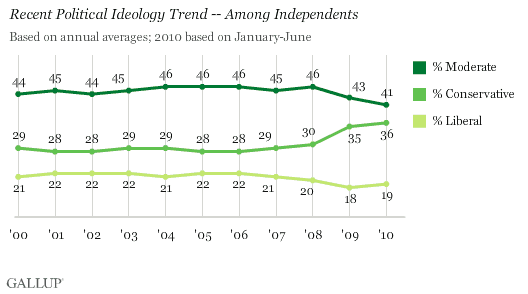PRINCETON, NJ -- Conservatives have maintained their leading position among U.S. ideological groups in the first half of 2010. Gallup finds 42% of Americans describing themselves as either very conservative or conservative. This is up slightly from the 40% seen for all of 2009 and contrasts with the 20% calling themselves liberal or very liberal.

The 2010 results are based on eight Gallup and USA Today/Gallup surveys conducted from January through June, encompassing interviews with more than 8,000 U.S. adults. The 42% identifying as conservative represents a continuation of the slight but statistically significant edge conservatives achieved over moderates in 2009. Should that figure hold for all of 2010, it would represent the highest annual percentage identifying as conservative in Gallup's history of measuring ideology with this wording, dating to 1992.
The recent rise in conservatism's fortunes follows a decline seen after 2003; liberalism has experienced the opposite pattern. From 1993 to 2002, the ideological trend had been fairly stable, with roughly 40% identifying as moderate, 38% as conservative, and 19% as liberal. Before that, the presidential bid of independent candidate Ross Perot may have contributed to a heightened proportion of Americans (43%) calling themselves moderate in 1992.
Partisans Maintain Their 2009 Ideological Leanings
There are no significant changes so far in 2010 compared with 2009 in how Republicans, Democrats, and independents characterize their respective political views. Consistent with the patterns seen last year, nearly 4 in 10 Democrats call themselves liberal and a similar proportion of Democrats say they are moderate.
Longer term, Democrats have grown increasingly liberal in their political orientation.

Seven in 10 Republicans continue to call themselves conservative, similar to 2009, while most of the remaining Republicans identify as moderate. Since 2002, however, the percentage conservative has increased by 10 points.

Independents today are slightly more likely to say they are moderate than conservative, with fewer than 20% identifying as liberal. While this is similar to 2009, it represents an increase in conservatism among this group since 2008.

Bottom Line
The ideological orientation of Americans seen thus far in 2010 would represent a record-high level of conservatism (since at least 1992) if it is maintained for the full year. This follows an increase in the percentage of conservatives in 2009 that was fueled by heightened conservatism among independents, a pattern that continues today.
Survey Methods
Results are based on the combined findings of eight separate Gallup and USA Today/Gallup surveys conducted from January through June 2010. For results based on the total sample of 8,207 national adults, one can say with 95% confidence that the maximum margin of sampling error is ±1 percentage point.
Party breakdowns for 2010 are based on 2,395 Republicans, 3,134 independents, and 2,565 Democrats. For results based on samples of these sizes, one can say with 95% confidence that the maximum margin of sampling error is ±2 percentage points.
Interviews are conducted with respondents on landline telephones (for respondents with a landline telephone) and cellular phones (for respondents who are cell phone-only). Each sample includes a minimum quota of 150 cell phone-only respondents and 850 landline respondents, with additional minimum quotas among landline respondents for gender within region. Landline respondents are chosen at random within each household on the basis of which member had the most recent birthday.
Samples are weighted by gender, age, race, education, region, and phone lines. Demographic weighting targets are based on the March 2009 Current Population Survey figures for the aged 18 and older non-institutionalized population living in continental U.S. telephone households. All reported margins of sampling error include the computed design effects for weighting and sample design.
In addition to sampling error, question wording and practical difficulties in conducting surveys can introduce error or bias into the findings of public opinion polls.
For more details on Gallup's polling methodology, visit https://www.gallup.com/.
